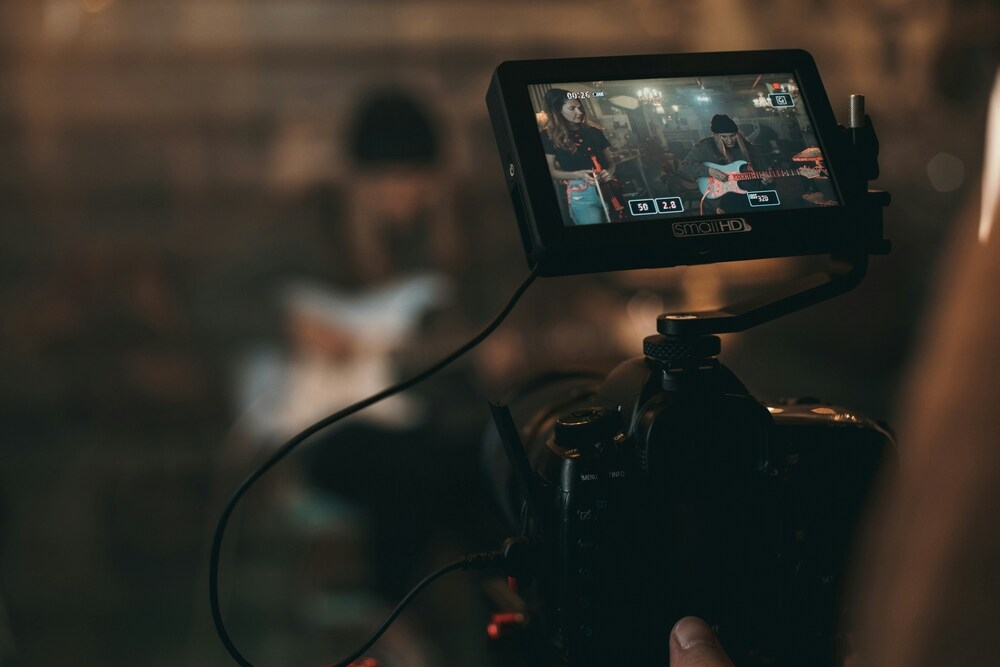Non Copyright Music for Short Films
Elevate your short films with the perfect score! Discover how non-copyright music can transform your storytelling, offering a blend of creativity and legal ease. Dive in to learn key tips on selecting and integrating music that resonates. Make your next film project unforgettable—click to explore!
There's more music!
That's only the tip of the iceberg. We have many more songs, all available with our lifetime licenses:
Why you should purchase from us
Discover the simplest and most cost-effective way to secure a lifetime license – pay once and never worry about account creation or password hassles again! Our licenses are your ticket to the best music, valid for any project, forever.
Get your license now!Use our music on...
Music Plans
Pay once, use for a lifetime
You’ll never have to worry again about copyrights or claims.
Starter
Suited for personal projects and social media (Youtube not included)
$49 / forever
Buy plan- Personal projects
- Social Media
- Clients work
- Online Advertising
- TV, Cinema and Radio
Personal
Most popular
Ideal for Youtube. apps, podcast and gameplays. Unlimited downloads and channels.
$99 / forever
Buy plan- Social Media
- Youtube & Streaming
- Apps & Videogames
- Clients work
- Online Advertising
- TV, Cinema and Radio
Business
Ideal if you're a freelancer or a business. All covered, unlimited downloads and channels
$199 / forever
Buy plan- Any Possible Use Case
- Clients work
- Online Advertising
- TV, Cinema and Radio
👉No need to create an account
👉A lifetime license, forever
👉No more ‘clearing’ channels
We currently offer 241 songs from 30 different genres
Testimonials
Don't take our word for it
“I was skeptical at first but Legis Music has exceeded my expectations. Their music library is diverse and constantly updated, making it easy to find the perfect track for any project. Plus, the peace of mind that comes with that royalty-free license is priceless.”

“@legismusic has made my life as a video editor so much easier. The lifetime license is a no-brainer and the fact that I don’t have to worry about clearing channels or getting copyright strikes is a huge weight off my shoulders. The affordable cost and extensive music library make it the go-to source for all my music needs.”

“As a podcast creator, finding the right music to complement my content can be a challenge, but Legis Music has made it so easy. Their lifetime licenses are affordable and the fact that I can use the music on Spotify and Apple Music is a huge relief. A no-brainer for any podcaster.”

“I was blown away by the value offered by Legis Music's lifetime royalty-free licenses. The cost is incredibly affordable and having the peace of mind to use the music for my clients without worrying about copyright strikes is priceless. I highly recommend this to anyone in need of music for their projects.”

“It was important for me to find a cost-effective solution for my company’s music needs. Legis Music’s business plan was the perfect fit and the lifetime licenses have been a game-changer. We can now use the music for all of our projects without any worries about copyright strikes. Highly recommend to any business in need of music.”

“The quality of the music is top-notch, and the licensing terms are crystal clear, saving me from any copyright hassles.”

“Legis Music has improved the way I create content. The selection of royalty-free music is great and the quality is unbeatable. I can now add the perfect sound to my videos without any stress or added costs. Highly recommended!”

“I've been using Legis Music for my YouTube channel for the past few months, and I couldn't be happier with the service.”

“As a video game creator, having access to high-quality music for my games is crucial. @legismusic lifetime licenses are a steal and the fact that I don’t have to worry about any type of copyrights in the future is a huge relief. The extensive library makes it easy to find the perfect tracks for my games.”

“The audio quality is excellent, and I've never experienced any copyright issues since using their music. The licensing terms are transparent, which is essential for content creators like myself.”

“As a freelance producer, I need to keep costs down and Legis Music has been a huge help for me. The user-friendly platform and affordable pricing make it easy for me to access top-notch music for my clients. Anyone in need of royalty-free music should give it a shot.”

Key Takeaways
- Creative Freedom and Practicality: Non-copyright music offers filmmakers a unique combination of creative freedom and practical benefits, allowing them to enhance their films without facing legal and financial constraints associated with copyrighted music.
- Emotional Depth and Thematic Resonance: Carefully selected music can significantly enhance the emotional impact and thematic depth of a film, making the narrative more compelling and engaging for audiences.
- Diverse Musical Possibilities: The use of non-copyright music opens up a vast array of musical styles and genres for filmmakers to explore, encouraging a more inventive and harmonious blend of visual and auditory storytelling elements.
- Cost-Effective Resource: Non-copyright music alleviates budgetary concerns, providing a cost-effective solution for enhancing film production value without compromising on quality or artistic vision.
- Legal Simplicity: Opting for non-copyright music simplifies the legal aspects of film production, allowing filmmakers to focus more on the creative process without worrying about copyright infringement issues.
- Community and Resources: The growing community of filmmakers and the abundance of online resources and tools make finding and incorporating non-copyright music into films more accessible than ever, fostering a culture of sharing and collaboration within the industry.
- Innovation and Adaptability: The article highlights the innovative spirit and adaptability of independent filmmakers, who can turn the limitations of budget and copyright into opportunities for creative expression and storytelling.
- A Testament to Independent Filmmaking: The use of non-copyright music embodies the resilience and creativity of the independent filmmaking community, showcasing how constraints can be transformed into catalysts for artistic innovation and expression.
In the art of filmmaking, music transcends mere background sound; it becomes a narrative force, capable of shaping the audience’s emotional journey and elevating the visual storytelling of a short film.
Within the compact format of a short film, every element must be meticulously chosen to convey the story effectively, and music is no exception.
This article embarks on exploring the treasure trove of non-copyright music—a sanctuary for filmmakers seeking to infuse their creations with depth and emotion without the burden of copyright restrictions.
By delving into this realm, filmmakers not only navigate the legal landscape safely but also unlock a vast array of musical possibilities that can enrich their films, making each scene more poignant and memorable.

Understanding copyright in music
At its core, copyright law is designed to protect the rights of creators over their original works, including music compositions and recordings.
This protection ensures that creators can control the use of their work and receive compensation for it.
However, for filmmakers, especially those working on short films with limited budgets, **navigating copyright in music can be a daunting task. **
The landscape is divided into three main territories:
- Copyrighted music: This category includes most commercial music released by artists and labels. Using copyrighted music in films requires obtaining permission and potentially paying licensing fees, which can be prohibitive for independent filmmakers.
- Royalty-Free music: Often misunderstood as completely free, royalty-free music is more about the freedom from ongoing royalty payments. Filmmakers can pay a one-time fee to use the music as many times as they like, but the initial cost can still be a factor to consider.
- Public Domain music: Music in the public domain is free from copyright restrictions, either because the copyright has expired or was never applicable. These works can be used without seeking permission or paying fees, offering a valuable resource for filmmakers.
Understanding these distinctions is crucial for filmmakers who wish to incorporate music into their short films without infringing on copyright laws.
This knowledge not only prevents legal complications but also **opens up a world of musical options that can be used to enhance the narrative impact of their films. **
The following sections will delve deeper into how filmmakers can navigate this landscape, find and select the right music, and creatively integrate it into their projects for maximum emotional and aesthetic effect.
Benefits of using non copyright music in short films
The strategic use of non-copyright music in short films offers a myriad of advantages that can significantly enhance the production value and emotional depth of these projects.
Here are the key benefits:
- Cost-effectiveness: For many independent filmmakers and those working with limited budgets, the costs associated with licensing copyrighted music can be prohibitive. Non-copyright music, available through public domain sources or under Creative Commons licenses, can be acquired for free or for a minimal cost, making it an economically viable option.ç
- Legal simplicity: Navigating the legalities of music licensing is a complex process that can be daunting for filmmakers. By opting for non-copyright music, the legal process is simplified, as there are no copyright holders from whom to seek permission or to whom fees must be paid. This significantly reduces the risk of legal disputes or copyright infringement claims.
- Enhancing accessibility and creativity: Utilizing non-copyright music opens up a vast array of musical genres and styles that might not have been accessible or considered due to budgetary or legal constraints. This freedom encourages filmmakers to experiment with different sounds and compositions, fostering creativity and allowing for a more authentic alignment of music with the film’s narrative and mood.
Finding non copyright music for your film
Discovering the perfect soundtrack for your short film within the realm of non-copyright music requires knowing where to look and how to search effectively.
Here are strategies for finding the right music:
- Top platforms and libraries: There are numerous online platforms and music libraries dedicated to providing non-copyright or Creative Commons licensed music. Websites such as the Free Music Archive, Jamendo, and Incompetech offer extensive collections of music across various genres, making it easier for filmmakers to find tracks that suit their film’s mood and theme. Additionally, platforms like YouTube Audio Library provide royalty-free music specifically for video content, ensuring compatibility and ease of use.
- How to search for the right track: When searching for music, use specific keywords related to the mood, genre, or instrumentation you envision for your film. Many platforms allow you to filter searches by genre, mood, tempo, and even the type of Creative Commons license, helping you narrow down the options to find the ideal soundtrack.
- Tips for Creative Commons and Public Domain music: Familiarize yourself with the different types of Creative Commons licenses to ensure the music you choose aligns with your film’s distribution plans. Some licenses may require attribution or restrict commercial use, so it’s important to understand these details. For public domain music, look for reputable sources that confirm the copyright status, ensuring the music is truly free to use without restrictions.
By leveraging these strategies, filmmakers can effectively navigate the wealth of non-copyright music available, finding high-quality tracks that enhance their short films without the worry of copyright infringement or licensing fees.
Selecting the perfect music for your film
The selection of music for a short film involves more than just legal considerations; it’s an artistic choice that can significantly impact the narrative and emotional tone of the film.
Here are key factors to consider:
- Matching music to film genre and mood: The music should complement the genre of the film, whether it’s a drama, comedy, horror, or any other genre. The mood of the music should align with the scenes it accompanies, enhancing the storytelling without overwhelming it. For instance, a suspenseful thriller might benefit from a soundtrack that builds tension, while a romantic scene could be elevated with a softer, more melodic piece.
- Considering audience and cultural relevance: Understand your target audience and the cultural context of your film. Music that resonates with your audience’s tastes and cultural backgrounds can make the film more engaging and relatable. Incorporating music that reflects the film’s cultural setting can also add authenticity and depth to the narrative.
- Quality and technical considerations: Ensure the music is of high quality, both in terms of composition and audio production. Poor-quality audio can detract from the viewer’s experience. Additionally, consider how the music will be integrated into the film’s soundscape, including its interaction with dialogue and sound effects.
Legal considerations and compliance
Using non-copyright music still requires attention to legal details to ensure compliance with any applicable licenses or copyright exceptions.
Here are important considerations:
- Understanding and adhering to license agreements: Even music that is free to use often comes with certain conditions, such as attribution requirements or limitations on commercial use. Carefully review the terms of use for any track you plan to incorporate into your film to ensure compliance.
- Attribution requirements: Many Creative Commons licenses require you to give credit to the original artist in your film’s credits or accompanying materials. Make sure to follow the specified attribution format to honor the creator’s contributions.
- Avoiding common legal pitfalls: Be wary of using music that has unclear copyright status or insufficient documentation. When in doubt, seek clarification or consider using a different track to avoid potential legal issues.
Incorporating music into your film
Effectively integrating music into your short film is both a technical and creative challenge.
Here are some tips for successful incorporation:
- Editing and mixing for optimal sound: Balance the music with other audio elements, such as dialogue and sound effects, to ensure clarity and coherence in the film’s overall soundscape. Use audio editing software to adjust levels and apply effects that enhance the emotional impact of the music.
- Creative ways to use music in storytelling: Music can be used to foreshadow events, reflect character emotions, or highlight thematic elements of the story. Experiment with different musical cues and motifs to deepen the narrative and engage the audience on an emotional level.
By thoughtfully selecting and skillfully incorporating non-copyright music, filmmakers can elevate their short films, enriching the storytelling and emotional resonance through the power of sound.
Resources and tools for filmmakers
To navigate the landscape of non-copyright music and incorporate it into short films effectively, **filmmakers can rely on a variety of resources and tools. **
Here’s a rundown of essential aids that can streamline the process:
- Recommended platforms for free music: Beyond the previously mentioned platforms, consider exploring sites like Bensound and Purple Planet for a diverse selection of royalty-free tracks. Each site has its unique collection and licensing terms, offering a plethora of options for filmmakers.
- Useful software for editing and mixing: Quality audio editing software is indispensable for filmmakers looking to incorporate music seamlessly into their projects. Programs like Audacity (free) and Adobe Audition (paid) provide robust editing tools for cutting, fading, and mixing tracks to achieve professional-grade audio quality.
- Communities and networks for filmmakers: Joining filmmaking communities, both online and offline, can provide valuable insights and support. Platforms such as Mandy Network , Stage 32 , and even specific forums on Reddit , serve as great resources for sharing experiences, seeking advice, and discovering new music resources.
Conclusion
Incorporating non-copyright music into short films offers a unique blend of creative freedom and practicality, providing a pathway for filmmakers to enrich their narratives without the constraints of traditional copyright barriers.
This approach not only alleviates financial and legal burdens but also opens up a rich tapestry of musical possibilities that can dramatically enhance the emotional depth and thematic resonance of a film.
Through the careful selection and integration of music, filmmakers are empowered to create more compelling and immersive stories that connect deeply with audiences.
The exploration of non-copyright music is not merely a workaround for budget constraints; it’s an artistic choice that broadens the horizon of storytelling.
It invites filmmakers to delve into a diverse pool of sounds and genres, encouraging a harmonious blend of visual and auditory elements that can elevate the viewer’s experience to new heights.
This journey through the landscape of accessible music underscores the importance of sound in film, highlighting its role in shaping the narrative, setting the tone, and evoking emotions.
As we conclude, the key takeaway for filmmakers is the importance of embracing non-copyright music as a valuable resource in their creative arsenal.
This exploration not only demands an understanding of the legal landscape but also **a keen sense of how music can complement and enhance the storytelling process. **
By navigating these challenges with creativity and diligence, filmmakers can unlock new dimensions of expression in their work, making each short film not just a story told but an experience shared.
In essence, the use of non-copyright music in short films encapsulates the spirit of innovation and adaptability that defines the independent filmmaking community.
It stands as a testament to the idea that great art can flourish within constraints, turning limitations into opportunities for creativity and expression.
- Key Takeaways
- Understanding copyright in music
- Benefits of using non copyright music in short films
- Finding non copyright music for your film
- Selecting the perfect music for your film
- Legal considerations and compliance
- Incorporating music into your film
- Resources and tools for filmmakers
- Conclusion